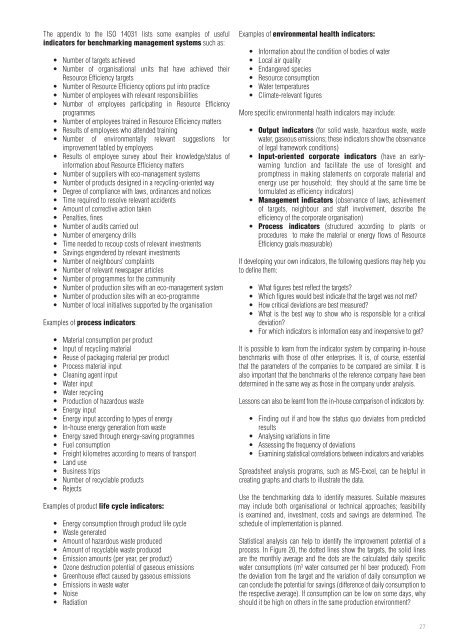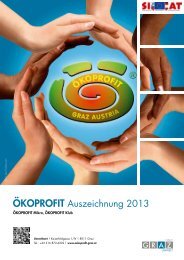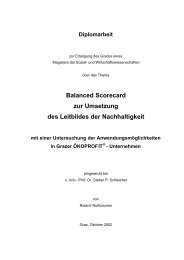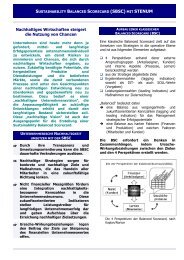Promoting Resource Efficiency in Small & Medium size ... - UNEP
Promoting Resource Efficiency in Small & Medium size ... - UNEP
Promoting Resource Efficiency in Small & Medium size ... - UNEP
You also want an ePaper? Increase the reach of your titles
YUMPU automatically turns print PDFs into web optimized ePapers that Google loves.
The appendix to the ISO 14031 lists some examples of useful<br />
<strong>in</strong>dicators for benchmark<strong>in</strong>g management systems such as:<br />
• Number of targets achieved<br />
• Number of organisational units that have achieved their<br />
<strong>Resource</strong> <strong>Efficiency</strong> targets<br />
• Number of <strong>Resource</strong> <strong>Efficiency</strong> options put <strong>in</strong>to practice<br />
• Number of employees with relevant responsibilities<br />
• Number of employees participat<strong>in</strong>g <strong>in</strong> <strong>Resource</strong> <strong>Efficiency</strong><br />
programmes<br />
• Number of employees tra<strong>in</strong>ed <strong>in</strong> <strong>Resource</strong> <strong>Efficiency</strong> matters<br />
• Results of employees who attended tra<strong>in</strong><strong>in</strong>g<br />
• Number of environmentally relevant suggestions for<br />
improvement tabled by employees<br />
• Results of employee survey about their knowledge/status of<br />
<strong>in</strong>formation about <strong>Resource</strong> <strong>Efficiency</strong> matters<br />
• Number of suppliers with eco-management systems<br />
• Number of products designed <strong>in</strong> a recycl<strong>in</strong>g-oriented way<br />
• Degree of compliance with laws, ord<strong>in</strong>ances and notices<br />
• Time required to resolve relevant accidents<br />
• Amount of corrective action taken<br />
• Penalties, f<strong>in</strong>es<br />
• Number of audits carried out<br />
• Number of emergency drills<br />
• Time needed to recoup costs of relevant <strong>in</strong>vestments<br />
• Sav<strong>in</strong>gs engendered by relevant <strong>in</strong>vestments<br />
• Number of neighbours’ compla<strong>in</strong>ts<br />
• Number of relevant newspaper articles<br />
• Number of programmes for the community<br />
• Number of production sites with an eco-management system<br />
• Number of production sites with an eco-programme<br />
• Number of local <strong>in</strong>itiatives supported by the organisation<br />
Examples of process <strong>in</strong>dicators:<br />
• Material consumption per product<br />
• Input of recycl<strong>in</strong>g material<br />
• Reuse of packag<strong>in</strong>g material per product<br />
• Process material <strong>in</strong>put<br />
• Clean<strong>in</strong>g agent <strong>in</strong>put<br />
• Water <strong>in</strong>put<br />
• Water recycl<strong>in</strong>g<br />
• Production of hazardous waste<br />
• Energy <strong>in</strong>put<br />
• Energy <strong>in</strong>put accord<strong>in</strong>g to types of energy<br />
• In-house energy generation from waste<br />
• Energy saved through energy-sav<strong>in</strong>g programmes<br />
• Fuel consumption<br />
• Freight kilometres accord<strong>in</strong>g to means of transport<br />
• Land use<br />
• Bus<strong>in</strong>ess trips<br />
• Number of recyclable products<br />
• Rejects<br />
Examples of product life cycle <strong>in</strong>dicators:<br />
• Energy consumption through product life cycle<br />
• Waste generated<br />
• Amount of hazardous waste produced<br />
• Amount of recyclable waste produced<br />
• Emission amounts (per year, per product)<br />
• Ozone destruction potential of gaseous emissions<br />
• Greenhouse effect caused by gaseous emissions<br />
• Emissions <strong>in</strong> waste water<br />
• Noise<br />
• Radiation<br />
Examples of environmental health <strong>in</strong>dicators:<br />
• Information about the condition of bodies of water<br />
• Local air quality<br />
• Endangered species<br />
• <strong>Resource</strong> consumption<br />
• Water temperatures<br />
• Climate-relevant figures<br />
More specific environmental health <strong>in</strong>dicators may <strong>in</strong>clude:<br />
• Output <strong>in</strong>dicators (for solid waste, hazardous waste, waste<br />
water, gaseous emissions; these <strong>in</strong>dicators show the observance<br />
of legal framework conditions)<br />
• Input-oriented corporate <strong>in</strong>dicators (have an earlywarn<strong>in</strong>g<br />
function and facilitate the use of foresight and<br />
promptness <strong>in</strong> mak<strong>in</strong>g statements on corporate material and<br />
energy use per household; they should at the same time be<br />
formulated as efficiency <strong>in</strong>dicators)<br />
• Management <strong>in</strong>dicators (observance of laws, achievement<br />
of targets, neighbour and staff <strong>in</strong>volvement, describe the<br />
efficiency of the corporate organisation)<br />
• Process <strong>in</strong>dicators (structured accord<strong>in</strong>g to plants or<br />
procedures to make the material or energy flows of <strong>Resource</strong><br />
<strong>Efficiency</strong> goals measurable)<br />
If develop<strong>in</strong>g your own <strong>in</strong>dicators, the follow<strong>in</strong>g questions may help you<br />
to def<strong>in</strong>e them:<br />
• What figures best reflect the targets?<br />
• Which figures would best <strong>in</strong>dicate that the target was not met?<br />
• How critical deviations are best measured?<br />
• What is the best way to show who is responsible for a critical<br />
deviation?<br />
• For which <strong>in</strong>dicators is <strong>in</strong>formation easy and <strong>in</strong>expensive to get?<br />
It is possible to learn from the <strong>in</strong>dicator system by compar<strong>in</strong>g <strong>in</strong>-house<br />
benchmarks with those of other enterprises. It is, of course, essential<br />
that the parameters of the companies to be compared are similar. It is<br />
also important that the benchmarks of the reference company have been<br />
determ<strong>in</strong>ed <strong>in</strong> the same way as those <strong>in</strong> the company under analysis.<br />
Lessons can also be learnt from the <strong>in</strong>-house comparison of <strong>in</strong>dicators by:<br />
• F<strong>in</strong>d<strong>in</strong>g out if and how the status quo deviates from predicted<br />
results<br />
• Analys<strong>in</strong>g variations <strong>in</strong> time<br />
• Assess<strong>in</strong>g the frequency of deviations<br />
• Exam<strong>in</strong><strong>in</strong>g statistical correlations between <strong>in</strong>dicators and variables<br />
Spreadsheet analysis programs, such as MS-Excel, can be helpful <strong>in</strong><br />
creat<strong>in</strong>g graphs and charts to illustrate the data.<br />
Use the benchmark<strong>in</strong>g data to identify measures. Suitable measures<br />
may <strong>in</strong>clude both organisational or technical approaches; feasibility<br />
is exam<strong>in</strong>ed and, <strong>in</strong>vestment, costs and sav<strong>in</strong>gs are determ<strong>in</strong>ed. The<br />
schedule of implementation is planned.<br />
Statistical analysis can help to identify the improvement potential of a<br />
process. In Figure 20, the dotted l<strong>in</strong>es show the targets, the solid l<strong>in</strong>es<br />
are the monthly average and the dots are the calculated daily specific<br />
water consumptions (m 3 water consumed per hl beer produced). From<br />
the deviation from the target and the variation of daily consumption we<br />
can conclude the potential for sav<strong>in</strong>gs (difference of daily consumption to<br />
the respective average). If consumption can be low on some days, why<br />
should it be high on others <strong>in</strong> the same production environment?<br />
27
















